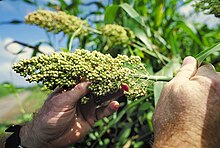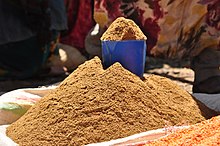Sorghum
| Sorghum | |
|---|---|

| |
| Sorghum bicolor | |
| Scientific classification | |
| Kingdom: | Plantae |
| Clade: | Tracheophytes |
| Clade: | Angiosperms |
| Clade: | Monocots |
| Clade: | Commelinids |
| Order: | Poales |
| Family: | Poaceae |
| Subfamily: | Panicoideae |
| Supertribe: | |
| Tribe: | Andropogoneae |
| Subtribe: | |
| Genus: | Sorghum Moench 1794, conserved name not Sorgum Adanson 1763 |
| Type species | |
| Sorghum bicolor | |
| Synonyms[1] | |
| |
Sorghum is a genus of about 25 species of flowering plants in the grass family (Poaceae). Some of these species are grown as cereals for human consumption and some in pastures for animals. One species, Sorghum bicolor, was originally domesticated in Africa and has since spread throughout the globe. Seventeen of the 25 species are native to Australia,[2][3] with the range of some extending to Africa, Asia, Mesoamerica, and certain islands in the Indian and Pacific Oceans.[4][5] One species is grown for grain, while many others are used as fodder plants, either cultivated in warm climates worldwide or naturalized in pasture lands.[6] Sorghum is in the subfamily Panicoideae and the tribe Andropogoneae (the tribe of big bluestem and sugarcane).
Cultivation and uses[]
One species, Sorghum bicolor,[7] native to Africa with many cultivated forms now,[8] is an important crop worldwide, used for food (as grain and in sorghum syrup or "sorghum molasses"), animal fodder, the production of alcoholic beverages, and biofuels. Sorghum's cultivation has been linked by archeological research back to ancient Sudan around 6,000 to 7,000 BP.[9]
All sorghums contain phenolic acids, and most contain flavonoids.[10] Sorghum grains are one of the highest food sources of the flavonoid proanthocyanidin.[11] Total phenol content (in both phenolic acids and flavonoids) is correlated with antioxidant activity.[10] Antioxidant activity is high in sorghums having dark pericarp and pigmented testa.[10] The antioxidant activity of sorghum may explain the reduced incidence of certain cancers in populations consuming sorghum.[10]
Popped sorghum is popular as a snack in India. The popped sorghum is similar to popcorn, but the puffs are smaller.[12] Recipes for popping sorghum by microwave, in a pot, etc., are readily available online.[13][12]
In China, sorghum flour is used in combination with wheat flour to make noodles and breads.[14]
Most varieties are drought- and heat-tolerant, nitrogen-efficient,[15] and are especially important in arid and semi-arid regions, where the grain is one of the staples for poor and rural people. These varieties form important components of forage in many tropical regions. S. bicolor is an important food crop in Africa, Central America, and South Asia, and is the 5th most important cereal crop grown in the world.[16][17]
In the early stages of the plants' growth, some species of sorghum can contain levels of hydrogen cyanide, hordenine, and nitrates, which are lethal to grazing animals. When stressed by drought or heat, plants can also contain toxic levels of cyanide and nitrates at later stages in growth.[18][19]
Role in global economy[]
Global demand for sorghum increased dramatically between 2013 and 2015, when China began purchasing US sorghum crops to use as livestock feed as a substitute for domestically grown corn. China purchased around $1 billion worth of American sorghum per year until April 2018, when China imposed retaliatory duties on American sorghum as part of the trade war between the two countries.[20]
Species[]
Accepted species[]
Species recorded include:[21]

- – northwestern Australia
- – Queensland
- Sorghum arundinaceum – Africa, Indian Subcontinent, Madagascar, islands of the western Indian Ocean
- Sorghum bicolor – cultivated sorghum, often individually called sorghum, also known as durra, jowari, or milo. Native to Sahel region of Africa; naturalized in many places
- – Northern Territory of Australia
- – Northern Territory, Western Australia
- – Thailand, Myanmar
- – India
- Sorghum × drummondii – Sahel and West Africa
- – Northern Territory, Western Australia
- – Northern Territory of Australia
- – Northern Territory, Queensland
- Sorghum halepense – Johnson grass – North Africa, islands of eastern Atlantic, southern Asia from Lebanon to Vietnam; naturalized in East Asia, Australia, the Americas
- – Northern Territory, Western Australia
- Sorghum intrans – Northern Territory, Western Australia
- – Philippines, Lesser Sunda Islands, Sulawesi, New Guinea, northern Australia
- Sorghum leiocladum – Queensland, New South Wales, Victoria
- – Northern Territory of Australia
- – Northern Territory, Western Australia
- – East Asia, Indian Subcontinent, Southeast Asia, New Guinea, Micronesia
- – Australia, New Guinea, Indonesia
- Sorghum propinquum – China, Indian Subcontinent, Southeast Asia, New Guinea, Christmas Island, Micronesia, Cook Islands
- Sorghum purpureosericeum – Sahel from Mali to Tanzania; Yemen, Oman, India
- – Northern Territory, Western Australia
- Sorghum timorense – Lesser Sunda Islands, Maluku, New Guinea, northern Australia
- – Mexico, Guatemala, Honduras
- – eastern + southern Africa from Ethiopia to Namibia; Oman
- – dry regions from Senegal to the Levant.
References[]
- ^ "World Checklist of Selected Plant Families: Royal Botanic Gardens, Kew". Retrieved 4 September 2016.
- ^ Sally L. Dillon; Peter K. Lawrence; Robert J. Henry; et al. "Sorghum laxiflorum and S. macrospermum, the Australian native species most closely related to the cultivated S. bicolor based on ITS1 and ndhF sequence analysis of 28 Sorghum species". Southern Cross Plant Science. Southern Cross University. Retrieved 28 February 2016.
- ^ Australia, Atlas of Living. "Sorghum - Atlas of Living Australia". Retrieved 4 September 2016.
- ^ "Tropicos, Sorghum Moench". Tropicos.org. Retrieved 2018-05-31.
- ^ "Flora of China Vol. 22 Page 600 高粱属 gao liang shu Sorghum Moench, Methodus. 207. 1794". Efloras.org. Retrieved 2018-05-31.
- ^ "Sorghum". County-level distribution maps from the North American Plant Atlas (NAPA). Biota of North America Program (BONAP). 2014. Retrieved 4 September 2016.
- ^ Mutegi, Evans; Sagnard, Fabrice; Muraya, Moses; et al. (2010-02-01). "Ecogeographical distribution of wild, weedy and cultivated Sorghum bicolor (L.) Moench in Kenya: implications for conservation and crop-to-wild gene flow" (PDF). Genetic Resources and Crop Evolution. 57 (2): 243–253. doi:10.1007/s10722-009-9466-7. S2CID 28318220.
- ^ Stefan Hauser, Lydia Wairegi, Charles L. A. Asadu, Damian O. Asawalam, Grace Jokthan, Utiang Ugbe (2015). "Sorghum- and millet-legume cropping systems" (PDF). CABI and Africa Soil Health Consortium. Retrieved 7 October 2018.CS1 maint: uses authors parameter (link)
- ^ Carney, Judith (2009). In the Shadow of Slavery. Berkeley and Los Angeles, California: University of California Press. p. 16. ISBN 9780520269965.
- ^ Jump up to: a b c d Dykes, Linda; Rooney, Lloyd W. (2006). "Sorghum and millet phenols and antioxidants" (PDF). Journal of Cereal Science. 44 (3): 236–251. doi:10.1016/j.jcs.2006.06.007.
- ^ Luca, Simon Vlad; Macovei, Irina; Bujor, Alexandra; Miron, Anca; Skalicka-Woźniak, Krystyna; Aprotosoaie, Ana Clara; Trifan, Adriana (2020). "Bioactivity of dietary polyphenols: The role of metabolites". Critical Reviews in Food Science and Nutrition. 60 (4): 626–659. doi:10.1080/10408398.2018.1546669. PMID 30614249. S2CID 58651581.
- ^ Jump up to: a b "Popped Sorghum". Recipes. Bob's Red Mill. 2021. Retrieved 2021-02-17.
- ^ "Popped Sorghum". Recipes. Whole Foods Market. 2021. Retrieved 2021-02-17.
- ^ Longmeimei cooking channel: 第一次做高粱馒头和面条,费了很大功夫Sorghum Bread and Sorghum Noodles, retrieved 2021-06-26
- ^ Mulhollem, Jeff (10 August 2020). "Flavonoids' presence in sorghum roots may lead to frost-resistant crop". Pennsylvania State University.
… sorghum is a crop that can respond to climate change because of its high water- and nitrogen-use efficiency …
- ^ Tove Danovich (15 December 2015). "Move over, quinoa: sorghum is the new 'wonder grain'". The Guardian. Retrieved 31 July 2018.
- ^ Willy H. Verheye, ed. (2010). "Growth and Production of Sorghum and Millets". Soils, Plant Growth and Crop Production. II. EOLSS Publishers. ISBN 978-1-84826-368-0.
- ^ "Cyanide (prussic acid) and nitrate in sorghum crops Primary industries and fisheries". Queensland Government. 7 November 2018. Retrieved 2021-05-13.
- ^ "Sorghum". Agriculture Victoria. The State of Victoria. Archived from the original on 2019-10-02. Retrieved 2018-10-15.
- ^ "Sorghum, targeted by tariffs, is a U.S. crop China started buying only five years ago". LA Times. Apr 18, 2018. Retrieved 28 January 2019.
- ^ "The Plant List: Sorghum". Royal Botanic Gardens Kew and Missouri Botanic Garden. 2013. Retrieved 28 February 2017.
Further reading[]
- Watson, Andrew M. (1983). Agricultural Innovation in the Early Islamic World: The Diffusion of Crops and Farming Techniques, 700–1100. Cambridge: Cambridge University Press. ISBN 0-521-24711-X.
External links[]
| Wikimedia Commons has media related to Sorghum. |
| Wikibooks Cookbook has a recipe/module on |
- . Encyclopædia Britannica. 25 (11th ed.). 1911.
- FAO Report (1995) "Sorghum and millets in human nutrition"
- Sorghum on US Grains Council Web Site
- Sweet Sorghum Ethanol Association, organization for the promotion and development of sweet Sorghum as a source for biofuels, especially ethanol
- Sorghum
- Cereals
- Forages
- Tropical agriculture
- Poaceae genera